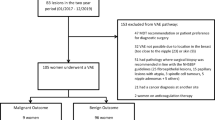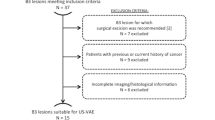Abstract
Background
Image-guided interventional techniques such as vacuum-assisted biopsy are being increasingly utilised in the diagnosis and management of breast conditions. The purpose of this study was to report the outcome of a series of vacuum-assisted biopsies and vacuum-assisted excisions performed by specialist breast surgeons in a largely outpatient setting.
Methods
An Australian multicentre trial of ultrasound-guided surgeon-performed vacuum-assisted biopsy (VAB) and vacuum-assisted excision (VAE) of breast lesions was conducted involving three surgeons in three participating centres. VAEs were performed for presumed or proven benign breast lesions only.
Results
A total of 225 surgeon-performed ultrasound-guided vacuum-assisted procedures were undertaken in 197 patients. Of the 225 VAB procedures, 51 (22.7%) were performed as diagnostic cores and 174 (77.3%) were undertaken as core excisions. Of the 174 VAE procedures undertaken with intent of completely excising the lesion, successful excision of the lesion was achieved in 165 of these cases (94.8%), with complete excision being judged by the absence of any lesion seen on ultrasound following the procedure or the absence of the lesion on a subsequent interval ultrasound examination. A total of 199 procedures were performed in the outpatients setting under local anaesthesia, and 26 procedures were performed in an operating theatre setting under neurolept anaesthesia. The average size of lesions was 19.3 mm in the diagnostic core group and 10.6 mm in the core excision group. The average time for either procedure was approximately 14 min.
Conclusion
Specialist breast surgeons familiar with ultrasound can be readily upskilled to perform vacuum-assisted procedures safely and expeditiously. VAE represents a minimally invasive method of breast lesion management and is a technique with which breast surgeons should become adept.



Similar content being viewed by others
References
Fraznen S, Zajicek J (1968) Aspiration biopsy in diagnosis of palpable lesions of the breast. Critical review of 3479 consecutive biopsies. Acta Radiol Therapy Phys Biol 7(4):241–262
Bennett I, Saboo A (2019) The evolving role of vacuum-assisted biopsy of the breast: a progression from fine-needle aspiration biopsy. World J Surg 43:7932
Parker SH, Burbank F, Jackman RJ, Aucreman CJ, Cardenosa G, Cink TM et al (1994) Percutaneous large-core breast biopsy: a multi-institutional study. Radiology 193:359–364
Parker SH, Klaus AJ, McWey PJ, Schilling KJ, Cupples TE, Duchesne N, Guenin MA, Harness JK (2001) Sonographically guided directional vacuum-assisted breast biopsy using a handheld device. AJR Am J Roentgenol 177(2):405–408
Bennett I (2017) The changing role of vacuum-assisted biopsy of the breast: a new prototype of minimally invasive breast surgery. Clin Breast Cancer 17(5):323–325
Sperber F, Blank A, Metser U et al (2003) Diagnosis and treatment of breast fibroadenomas by ultrasound-guided vacuum-assisted biopsy. Arch Surg 138:796–800
Park HL, Lee SH, Kim JY et al (2005) Excision of benign breast disease by ultrasound-guided vacuum assisted biopsy device (mammotome). J Korean Surg Soc 68:96–101
Pinder SE, Shaaban A, Deb R, Desai A, Gandhi A et al (2018) NHS breast screening multidisciplinary working group guidelines for the diagnosis and management of breast lesions of uncertain malignant potential on core biopsy (B3 lesions). Clin Radiol 73(8):682–692
Strachan C, Horgan K, Millican-Slater RA et al (2016) Outcome of a new patient pathway for managing B3 breast lesions by vacuum-assisted biopsy: time to change current UK practice? J Clin Pathol 69(3):248–254
Wang HH, Ductaman BS, Eick D (1989) Comparative features of ductal carcinoma in situ and infiltrating ductal carcinoma of the breast on fine-needle aspiration biopsy. Am J Clin Pathol 92:736–740
Brennan ME, Turner RM, Ciatto S, Marinovich ML, French JR, Macaskill P, Houssami N (2011) Ductal carcinoma in situ at core-needle biopsy: meta-analysis of underestimation and predictors of invasive breast cancer. Radiology 260(1):119–128
Fine RE, Boyd BA, Whitworth PW, Kim JA, Harness JK, Burak WE (2002) Percutaneous removal of benign masses using a vacuum-assisted hand-held device with ultrasound guidance. Am J Surg 184:332–336
Fine RE, Whitworth PW, Kim JA, Harness JK, Boyd BA, Burak WE Jr (2003) Low-risk palpable breast masses removed using a vacuum-assisted hand-held device. Am J Surg 186:362–367
Rageth CJ, O’Flynn E, Comstock C, Kurtz C, Kubik R (2016) First International Consensus Conference on lesions of uncertain malignant potential in the breast (B3 lesions). Breast Cancer Res Treat 159(2):203–213
Rageth CJ, Flynn E, Pinker K, Kubik-Huch R, Mundinger A et al (2019) Second International Consensus Conference on lesions of uncertain malignant potential in the breast (B3 lesions). Breast Cancer Res Treat 174:279–296
Rubio IT, Salazar JP, Miranda I, de Torres J, Rus MN et al (2019) Percutaneous ultrasound-guided vacuum-assisted excision of benign breast lesions: a learning curve to assess outcomes. Br J Radiol 92:1094
Hyung Seok Park & Chang Wan Jeon (2014) Learning curve for breast mass excision using a vacuum-assisted biopsy system. Minim Invasive Ther Allied Technol 23(4):235–240
Fine RE, Israel PZ, Walker LC et al (2001) A prospective study of the removal rate of imaged breast lesions by an 11-gauge vacuum-assisted biopsy probe system. Am J Surg 182:335–340
Vargas HI, Agbunag RV, Khaikhali I (2000) State of the art of minimally invasive breast biopsy: principles and practice. Breast Cancer 7:370–379
Wang ZL, Li JL, Su L, Zhang YF, Tang J (2009) An evaluation of a 10-gauge vacuum-assisted system for ultrasound-guided excision of clinically benign breast lesions. The Breast 18(3):192–196
Funding
This trial was supported by BARD Australia (BD) who provided the ultrasound units used in this clinical study.
Author information
Authors and Affiliations
Corresponding author
Additional information
Publisher's Note
Springer Nature remains neutral with regard to jurisdictional claims in published maps and institutional affiliations.
Rights and permissions
About this article
Cite this article
Bennett, I., de Viana, D., Law, M. et al. Surgeon-Performed Vacuum-Assisted Biopsy of the Breast: Results from a Multicentre Australian Study. World J Surg 44, 819–824 (2020). https://doi.org/10.1007/s00268-019-05266-7
Published:
Issue Date:
DOI: https://doi.org/10.1007/s00268-019-05266-7




